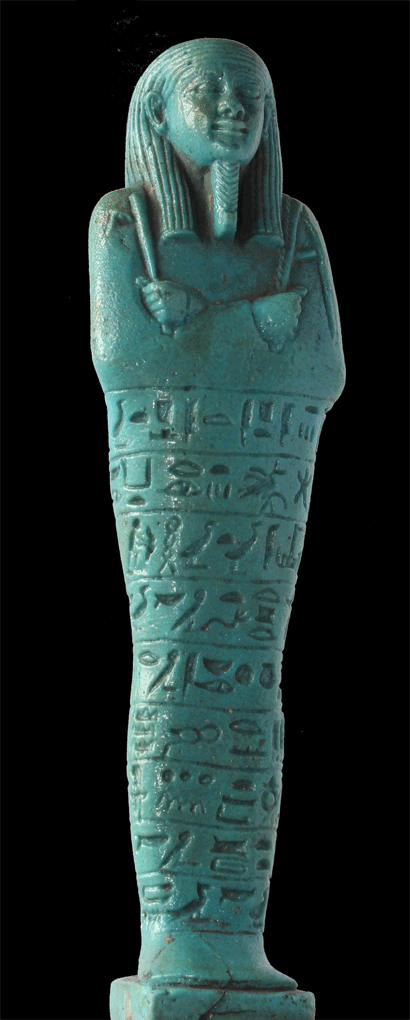|
|
|||||||
|
|
|
|
|
|
|
|
|
|
|
||
|
|
|
|
|
|
|||||||||||
|
|
|
|
|
|
|
|
|
|
|
|
|
|
|
|||||||||||||||||||||
|
Ptolemaic Period
During the Ptolemaic Period, the glaze on ushabtis is often quite thick.
Sometimes the figures are made in bichrome glaze, usually two contrasting
shades of blue - thus perhaps a pale blue for the torso and a deeper blue for
the wig [165]. The wigs themselves, although being tripartite, are less voluminous and rarely
show details of striations. Inscriptions are also sometimes highlighted in a
darker blue but because of the thickness of the overall glaze the inscriptions
are less defined than during the Late Period and sometimes difficult to read [166]. There was a general decline in the quality of the ushabtis and they gradually
faded from use with the advent of Roman times.
There are a number of so-called pseudo-shabtis to be found in museum collections
and also circulating on the art market from time to time. These are considered
by a few Egyptologists to be from Roman times and apparently excavated in sites
across Europe. They are apparently regarded as symbols associated with the cult
of Osiris and Isis. They are made of pottery or plaster, are inscribed with
meaningless inscriptions, always include a cartouche - usually for Thutmose III
of the New Kingdom and carry flails instead of a pick and hoe
[167]-[169]. These are widely considered to be 19th Century in date and made as souvenirs
for those visiting Egypt on the Grand Tour. Similar figurines are made in Egypt
for tourists to this day.
|
|
||||||||||||||||||||
|
Select any group to enlarge
|
|
||||||||||||||||||||
|
|
|||||||||||||||||||||
|
|
|||||||||||||||||||||
|
|
|||||||||||||||||||||
|
[165]
|
[166]
|
|
|||||||||||||||||||
|
|
|||||||||||||||||||||
|
|
|||||||||||||||||||||
|
|
|||||||||||||||||||||
|
[167]
|
[168]
|
[169]
|
|
||||||||||||||||||
|
|
|||||||||||||||||||||
|
|
|||||||||||||||||||||
|
[165] [Tasherytnettekri] (Liverpool, WM 44.19.23)
[166] Illegible (Liverpool, WM 7.1.69.4)
[167] Pseudo-shabti (Leeds, 2000.0014)
[168] Pseudo-shabti (Leeds, 1972.0118)
[169] Pseudo-shabti (Warrington, 1913.118 - acquired in Luxor in 1890)
|
|
||||||||||||||||||||
|
|
|||||||||||||||||||||
|
|
|
|
|
|
|
|
|
|
|
|
|
|
|
|
|
|
|
|
|
|
|
